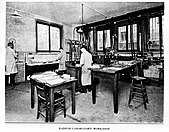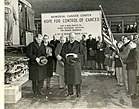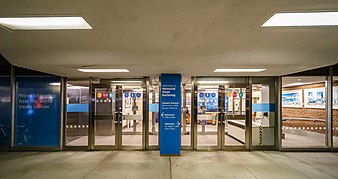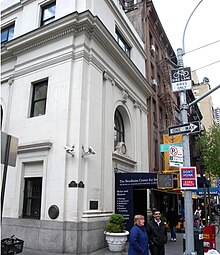Memorial Health University Physicians Family Care - East 66th Savannah, Ga
| Memorial Sloan Kettering Cancer Center | |
|---|---|
 | |
 Main entrance on York Avenue | |
 | |
| Geography | |
| Location | 1275 York Artery, Manhattan, New York, United states of america |
| Coordinates | twoscore°45′51″N 73°57′25″W / 40.764096°N 73.956842°W / 40.764096; -73.956842 Coordinates: 40°45′51″N 73°57′25″Westward / 40.764096°N 73.956842°W / 40.764096; -73.956842 |
| Organization | |
| Funding | Not-turn a profit hospital |
| Blazon | Specialist |
| Affiliated university | Cornell Academy, Weill Cornell Graduate Schoolhouse of Medical Sciences |
| Services | |
| Emergency department | Urgent intendance center |
| Beds | 498 (as of 2018) |
| Speciality | Oncology |
| History | |
| Sometime name(southward) | New York Cancer Infirmary |
| Opened | 1884 (1884) [1] (as New York Cancer Hospital) |
| Links | |
| Website | www |
| Lists | Hospitals in New York |
| Other links | Hospitals in Manhattan |

A radium laboratory at Memorial Infirmary, 1918

Memorial Infirmary, 1930

The relocated Memorial Hospital building, congenital between 1936 and 1939, standing on its present location on York Artery

Groundbreaking at the Sloan Kettering Plant, 1946


Schwartz Cancer Research Building archway, 1250 1st Ave
Memorial Sloan Kettering Cancer Center (MSK or MSKCC) is a cancer treatment and research institution in the civic of Manhattan in New York Urban center, founded in 1884 equally the New York Cancer Hospital. MSKCC is the largest and oldest individual cancer center in the world, and is one of 51 National Cancer Establish–designated Comprehensive Cancer Centers.[three] [4] Memorial Sloan Kettering is affiliated with Cornell University's medical schoolhouse. Its main campus is located at 1275 York Artery, betwixt 67th and 68th streets, in Manhattan.
According to U.South. News & World Report 2021-2022 Best Hospitals, Memorial Sloan Kettering Cancer Center (MSK) has been ranked as the number two hospital for cancer care in the nation.[5]
History [edit]
New York Cancer Hospital (1884–1934) [edit]
Memorial Hospital was founded on the Upper West Side of Manhattan[2] in 1884 as the New York Cancer Hospital by a group that included John Jacob Astor III and his wife Charlotte.[half dozen] The infirmary appointed as an attending surgeon William B. Coley, who pioneered an early form of immunotherapy to eradicate tumors.[7] Rose Hawthorne, daughter of writer Nathaniel Hawthorne, trained at that place in the summer of 1896 before founding her own order, Dominican Sisters of Hawthorne.[eight] In 1899, the hospital was renamed General Memorial Hospital for the Treatment of Cancer and Allied Diseases.[9] In 1902, Arabella Huntington made a $100,000 (approximately $3 million in 2018) bequest in retentivity of her late married man Collis Potter Huntington to establish the commencement cancer inquiry fund in the land, the Huntington Fund for Cancer Research.[six]
Around 1910 James Ewing, a professor at Cornell University's medical college, established a collaboration with Memorial Infirmary with the aid and funding of industrialist and philanthropist James Douglas, who gave $100,000 to endow twenty beds for clinical inquiry, equipment for working with radium, and a clinical laboratory for that purpose.[10] Douglas' enthusiasm and funding for development of radiation therapy for cancer inspired Ewing to become one of the pioneers in developing this handling.[ten] Ewing soon took over constructive leadership of clinical and laboratory research at Memorial.[10] In 1916 the hospital was renamed again, dropping "Full general" to become known just equally Memorial Hospital.[11] The first fellowship grooming programme in the US was created at Memorial in 1927, funded by the Rockefellers.[12] In 1931 the so-nearly-powerful 900k-volt X-ray tube was put into use in radiation-based cancer treatment at Memorial; the tube had been built by General Electric over several years.[thirteen] In 1931 Ewing was formally appointed president of the hospital, a role he had effectively played until and so,[10] and was featured on the cover of Time magazine every bit "Cancer Man Ewing";[14] the accompanying article described his role equally one of the most of import cancer doctors of his era.[xv] He worked at the Memorial until his retirement, in 1939.[xvi] Under his leadership, Memorial became a model for other cancer centers in the United States, combining patient care with clinical and laboratory research,[12] and it was said of him that "the human relationship of Ewing to the Memorial Infirmary tin best exist expressed in the words of Emerson, 'Every institution is simply the lengthening shadow of some man.' Dr. Ewing is the Memorial Hospital".[10]
Memorial Hospital and the Sloan Kettering Institute (1934–1980) [edit]
In 1934, John D. Rockefeller Jr. donated state on York Avenue for a new location.[17] Two years afterwards, he granted Memorial Infirmary $3,000,000 and the hospital began their move beyond town.[xviii] Memorial Hospital officially reopened at the new location in 1939.[xix] [20] In 1945, the chairman of General Motors, Alfred P. Sloan, donated $4,000,000 to create the Sloan-Kettering Institute for Cancer Inquiry through his Sloan Foundation, and Charles F. Kettering, GM'due south vice president and director of enquiry, personally agreed to oversee the organisation of a cancer research plan based on industrial techniques.[21] The originally contained enquiry institute was congenital adjacent to Memorial Hospital.[21]
In 1948 Cornelius P. Rhoads became the manager of Memorial. Rhoads had run chemic weapons programs for the US army in World War II, and had been involved in the work that led to the discovery that nitrogen mustards could potentially be used as cancer drugs.[22] : 91–92 He fostered a collaboration betwixt Joseph H. Burchenal, a clinician at Memorial and Gertrude B. Elion and George H. Hitchings at Burroughs Wellcome, who had discovered 6 MP; the collaboration led to the development and eventual wide use of this cancer drug.[22] : 91–92 [23]
From the mid-1950s to the mid-1960s Chester M. Southam conducted pioneering clinical inquiry on virotherapy and cancer immunotherapy at MSK; however he conducted his research on people without their informed consent. He did this to patients under his intendance or others' intendance, and to prisoners.[24] [25] In 1963 some doctors objected to the lack of consent in his experiments and reported him to the Regents of the Academy of the Country of New York which found him guilty of fraud, cant, and unprofessional conduct, and in the end he was placed on probation for a year.[24] [25] Southam's research experiments and the case at the Regents were followed in The New York Times.[26] [27] [28] [29] [30]
In 1960, Memorial Sloan Kettering Cancer Middle was formed equally a new corporation to coordinate the two institutions; John Heller, the erstwhile director of the National Cancer Found was named its president.[31] At the stop of the 1960s, as the field of pediatric oncology began seeing success in treating children with cancer, Memorial opened an outpatient pediatric day hospital, partly to bargain with the growing number of cancer survivors.[32] In the early 1970s, Burchenal and Benno Schmidt, a professional investor and trustee of MSK, were appointed to the presidential console that initiated the U.Due south. federal government's War on Cancer in the early 1970s.[22] : 184 When Congress passed the National Cancer Act of 1971 as role of that effort, Memorial Sloan Kettering was designated as one of only three Comprehensive Cancer Centers nationwide.[33] In 1977, Jimmie C. The netherlands established a full-time psychiatric service at MSK dedicated to helping people with cancer cope with their disease and its treatment; it was one of the first such programs and was role of the creation of the field of psycho-oncology.[34] [35]
Memorial Sloan Kettering Cancer Center (1980–present) [edit]
In 1980 Memorial Hospital and the Sloan-Kettering Found formally merged into a singular entity under the Memorial Sloan Kettering Cancer Middle proper noun.[20]
In 2000, erstwhile NIH manager Harold Varmus became the director of MSK.[36] During his tenure, he helped build new facilities, strengthened the bond between MSK'south clinical and research arms, and fostered collaborations with other institutions, including Weill-Cornell Medical College and Rockefeller University.[36]
In 2006, MSK opened the Mortimer B. Zuckerman Research Center, a 23-story edifice which houses more than 100 laboratories.[37]
Craig B. Thompson, oncologist and researcher, was appointed MSK's president and CEO in 2010.[38] The following year, MSK was rated the third well-nigh successful nonprofit in terms of FDA-approved drugs and vaccines, behind the National Institutes of Health and the University of California system.[39] In 2012, Thompson appointed José Baselga equally dr.-in-principal, who directed the clinical side of MSK.[40] That same year, a collaboration with IBM's Watson was announced with the goal of developing new tools and resources to better tailor diagnostic and handling recommendations for patients.[41] The director of SKI, the research arm of MSK, Joan Massagué was appointed in 2013.[42] Baselga resigned in September 2018 after data came out regarding millions of dollars he received from pharmaceutical companies without disclosing a fiscal conflict of interest.[43] [44]
In 2017, the Nutrient and Drug Administration approved an MSK-adult immunotherapy, Automobile-T, for certain applications in leukemia[45] [46] [47] and lymphoma.[48] [49] The FDA approved the first academic or commercial tumor identification test MSK-Bear upon in November 2018.[50] [51]
MSK has expanded into regional sites including Westchester (NY), Commack (Long Island), Hauppauge (Long Island), Rockville Eye (Long Island), Nassau (Long Isle), Bergen (NJ), Monmouth (NJ), and Basking Ridge (NJ).[52]
MSK currently employs over 1,200 physicians and treats patients with approximately 400 types of cancer annually.[53]
Associated facilities and programs [edit]

Bendheim Integrative Medicine Center
The Memorial Sloan Kettering Bendheim Integrative Medicine Middle occupies 1429 First Avenue on the corner of East 74th Street in Manhattan. The former banking concern was congenital in the 1930s by Perkins and Volition every bit architects. It was remodeled for use by Memorial Sloan Kettering in 1997.[54]
The Center for Prototype-Guided Intervention was opened in June 2010 in the Memorial Hospital building to oversee prototype guiding activities beyond MSK. In Oct 2012, the Sillerman Centre for Rehabilitation was opened, moving rehabilitation out of Memorial Hospital and closer to the Rockefeller Outpatient Pavilion.[55] [56]
The New York Proton Center opened in 2019 equally a partnership between Memorial Sloan Kettering, Montefiore Wellness, and Mount Sinai Health. The center was the beginning Proton therapy eye to open in New York State.[57] [58] The David H. Koch Centre for Cancer Care at Memorial Sloan Kettering Cancer Center opened at 530 East 74th Street between York Avenue and the FDR Drive January 2020. Perkins Eastman designed 750,000sq ft facility in collaboration with Ennead Architects, and ICRAVE.[59] [60] [61]
Training [edit]
Approximately 1,700 medical residents and Fellows are in training at MSK. There are 575 postdoctoral researchers preparation at MSK labs and a combined 288 PhD and MD-PhD candidates.[53]
In 2004, the Louis 5. Gerstner, Jr. Graduate School of Biomedical Sciences was opened at Memorial Sloan Kettering Cancer Eye.[62] The commencement students graduated in 2012.[63] As of January 2019, the dean of the graduate school is cell biologist Michael Overholtzer. The founding dean, serving for over a decade, was molecular biologist Ken Marians.[64]
The Tri-Institutional MD–PhD Program is a partnership of MSKCC, Weill Cornell Medicine, and The Rockefeller Academy. The dual degree plan takes advantage of the shut proximity of these three institutions for collaboration on biomedical inquiry and medical grooming. MSKCC as well has an bookish partnership with Weill Cornell Medicine known as the Weill Cornell Graduate School of Medical Sciences.[65]
Notable faculty [edit]
Presidents [edit]
- Craig B. Thompson, 2010–
- Harold Varmus, 2000–2010
- Paul A. Marks, 1980–1999
- Lewis Thomas, 1973–1980
- David Walsh, 1971–1973
- Richard D. Vanderwarker, 1962–1971
- John R. Heller, 1960–1961
Others [edit]
- James P. Allison
- Murray Brennan
- Ballad L. Dark-brown
- Samuel Danishefsky
- Nori Dattatreyudu
- Jeffrey Drebin
- Roger Granet
- Jimmie C. Holland
- David Kissane
- Iris Long
- Scott West. Lowe
- Joan Massagué
- Kenneth Offit
- Nikola P. Pavletich
- Marking S. Ptashne
- James Rothman
- Alexander Rudensky
- Charles Sawyers
- Lorenz Studer
- Lisa DeAngelis
Reputation [edit]
In 2015 Charity Spotter rated Memorial Sloan Kettering Cancer Center an "A".[66] Heads of the charity received $2,107,939 to $ii,639,669 salary/compensation from the clemency. CEO Craig B. Thompson received $2,554,085 salary/compensation from the clemency.[66]
Come across also [edit]
- Weill Cornell Graduate School of Medical Sciences
- Tri-Institutional Doc–PhD Program
- National Comprehensive Cancer Network
- Medico Anderson Cancer Heart
References [edit]
- ^ "Memorial Sloan Kettering Cancer Heart". Forbes.
- ^ a b Barbanel, Josh. "Would an Aardvark Alive Here?" The New York Times, September 17, 2006. Retrieved December 31, 2009.
- ^ "The New York Cancer Infirmary: laying the corner-stone of a much-needed institution". The New York Times. May xviii, 1884. Retrieved February iv, 2016.
- ^ "NCI-Designated Cancer Centers". National Cancer Institute. Apr v, 2012. Retrieved June eleven, 2019.
- ^ "Memorial Sloan Kettering Cancer Center - Cancer". US News and Earth Study. US News and World Report. Retrieved Nov 16, 2020.
- ^ a b Abel, Emily K. (2013). The inevitable hour: a history of caring for dying patients in America. Baltimore, Dr..: Johns Hopkins University Press. pp. 66–67. ISBN978-1421409191. OCLC 808769549.
- ^ Coley to Cure:The Story of the Cancer Research Institute. Cancer Inquiry Establish. 2014. pp. 12–13. Retrieved February four, 2016.
- ^ Smith, Fran; Himmel, Shiela (2013). Changing the Way We Die: Compassionate Terminate of Life Care and The Hospice Motion. Berkeley, California: Cleis Printing. p. 23. ISBN9781936740604. OCLC 839388370.
- ^ "SESSION OF THE SENATE.; Bills Passed and Introduced and Routine Concern Transacted". The New York Times. Feb 16, 1899. Retrieved Feb 27, 2016.
- ^ a b c d due east Tater, James B. (1951). "James Ewing—1866–1943" (PDF). Biographical Memoirs. Washington, D.C.: National University of Sciences.
- ^ Memorial Infirmary for the Handling of Cancer and Allied Diseases 30 First Annual Written report for the Year 1915 (Report). p. 19.
- ^ a b Wilkins, Sam A. Jr. (February 25, 1970). "James Ewing Society, 1940-1969: Presidential Address" (PDF). Cancer. 25 (2): 321–323. doi:10.1002/1097-0142(197002)25:2<321::Assistance-CNCR2820250207>3.0.CO;ii-R. PMID 4905156.
- ^ "900,000-VOLT TUBE TO Combat CANCER: Largest Ten-Ray Device of Kind Beingness Built by General Electric for Infirmary Here". The New York Times. March 1, 1931. Retrieved February iv, 2016.
- ^ Fourth dimension Mag Cover, January 12, 1931
- ^ "Cancer Crusade". January 12, 1931. Time 17(2):26
- ^ Brand, RA (March 2012). "Biographical sketch: James Stephen Ewing, Physician (1844-1943)". Clin Orthop Relat Res. 470 (3): 639–41. doi:ten.1007/s11999-011-2234-y. PMC3270161. PMID 22207564.
- ^ "Rockefeller Gives Block to Institute". The New York Times. Dec 28, 1934. Retrieved February iv, 2016.
- ^ "Rockefeller Provides $3,000,000 to Build Cancer Hospital Here". The New York Times. Apr 28, 1936. Retrieved February 4, 2016.
- ^ "THE MEMORIAL Hospital". The New York Times. June 16, 1939. Retrieved Feb 27, 2016.
- ^ a b Memorial Sloan Kettering Cancer Center, History & Milestones. Memorial Sloan Kettering Cancer Center website..
- ^ a b "Sloan, Kettering to Combat Cancer; Studying Sketch of Proposed Cancer Research Institute". The New York Times. August viii, 1945. p. i (cont'd p. 40).
- ^ a b c Mukherjee, Siddhartha (2010). The Emperor of All Maladies: A Biography of Cancer. New York. ISBN978-1439170915.
- ^ Bouton, Katherine (January 29, 1989). "The Nobel Pair". The New York Times.
- ^ a b Skloot, Rebecca (2010). The Immortal Life of Henrietta Lacks. New York: Crown/Classic. pp. 127–135. ISBN9780307589385.
- ^ a b Mulford, R.D. (1967). "Experimentation on Human Beings". Stanford Constabulary Review. 20 (1): 99–117. doi:ten.2307/1227417. JSTOR 1227417.
- ^ "fourteen Convicts Injected With Live Cancer Cells". The New York Times. June fifteen, 1956.
- ^ Johnston, Richard J.H. (April 15, 1957). "Cancer Defenses Found to Differ; Tests Indicate Victims Lack Some Mechanisms That Well Human Existence Has Cancer Recurred Deficiency Is Noted Warning past Southam". The New York Times.
- ^ Osmundsen, John A. (January 26, 1964). "Many Scientific Experts Condemn Ethics of Cancer Injection". The New York Times.
- ^ Plumb, Robert G. (March 22, 1964). "Scientists Carve up on Cancer Tests". The New York Times.
- ^ "Ruling is Upset on Cancer Test". The New York Times. July 8, 1964.
- ^ "U.S. Aide to Head Cancer Center: Dr. John R. Heller, Cured of Affliction, to Presume New Sloan-Kettering Post". The New York Times. April 19, 1960. Retrieved February iv, 2016.
- ^ Johnson, Rudy (December 3, 1972). "Parents Are on Team at Memorial'southward Day Hospital for Children With Cancer". The New York Times.
- ^ Marks, Paul; Sterngold, James (2014). On the Cancer Borderland: One Homo, 1 Disease, and a Medical Revolution . PublicAffairs. p. 91. ISBN978-1610392525.
- ^ Memorial Sloan-Kettering Cancer Middle Annual Report, 1977 (Report). p. 22.
- ^ Rosenthal, Elizabeth (July 20, 1997). "Scientist at Piece of work: Jimmie Kingdom of the netherlands; Listening to the Emotional Needs of Cancer Patients". The New York Times . Retrieved March 22, 2016.
- ^ a b "The Harold Varmus Papers: Memorial Sloan Kettering Cancer Middle, 2000-2010, and National Cancer Establish, 2010-2015". profiles.nlm.nih.gov . Retrieved April 22, 2016.
- ^ "Sloan Kettering Institute: About SKI". Memorial Sloan Kettering Cancer Heart. Retrieved December 4, 2017.
- ^ "Craig Thompson Named President of Memorial Sloan-Kettering Cancer Center". Memorial Sloan Kettering Cancer Center. Baronial 10, 2010. Retrieved January ten, 2013.
- ^ Stevens, AJ; Jensen, JJ; Wyller, Thousand; Kilgore, PC; Chatterjee, Southward; Rohrbaugh, ML (February ten, 2011). "The role of public-sector research in the discovery of drugs and vaccines". The New England Journal of Medicine. 364 (6): 535–41. doi:10.1056/NEJMsa1008268. PMID 21306239.
- ^ "Center names physician-in-main". HemOnc Today. November ten, 2012.
- ^ Memorial Sloan-Kettering Cancer Center Annual Report, 2013. p. 5.
- ^ Barajas, Carlos (November 26, 2013). "El español Joan Massagué, al frente del Sloan-Kettering de Nueva York". El Mundo.
- ^ "Why practise medical journals keep taking authors at their word? - STAT". STAT. September fourteen, 2018. Retrieved September 14, 2018.
- ^ "MSK Cancer Center Orders Staff to 'Practice a Better Task' of Disclosing Industry Ties". Retrieved September fourteen, 2018.
- ^ Commissioner, Office of the (September ten, 2019). "FDA approves Motorcar-T jail cell therapy to treat adults with certain types of large B-cell lymphoma". FDA . Retrieved October 15, 2019.
- ^ Wednesday, Matthew Tontonoz; August 30; 2017. "FDA Approves First Machine T Prison cell Therapy for Leukemia". Memorial Sloan Kettering Cancer Eye . Retrieved October fifteen, 2019.
{{cite web}}: CS1 maint: numeric names: authors list (link) - ^ "How Scientists Built a 'Living Drug' to Beat Cancer". Wired. ISSN 1059-1028. Retrieved October 29, 2019.
- ^ "Prison cell Therapy Manufacturing Tries "Building the Plane While Flight It"". GEN - Genetic Engineering and Biotechnology News. October 1, 2019. Retrieved October 29, 2019.
- ^ Thursday, Matthew Tontonoz; October 19; 2017. "FDA Approves CAR T Cell Therapy for Non-Hodgkin Lymphoma". Memorial Sloan Kettering Cancer Centre . Retrieved October 15, 2019.
{{cite spider web}}: CS1 maint: numeric names: authors list (link) - ^ "MSK-Touch: A Targeted Test for Mutations in Both Rare and Common Cancers". Memorial Sloan Kettering Cancer Centre . Retrieved October 15, 2019.
- ^ "Tisagenlecleucel (Kymriah) Canonical to Treat Some Lymphomas". National Cancer Constitute. May 22, 2018. Retrieved October 15, 2019.
- ^ "Memorial Sloan Kettering Cancer Center Regional Sites". Retrieved Oct 27, 2019.
- ^ a b "History & Milestones". Memorial Sloan Kettering Cancer Center. Retrieved November xiv, 2019.
- ^ Norval White; Elliot Willensky; Fran Leadon (June 14, 2010). AIA Guide to New York City. ISBN9780199758647 . Retrieved January 10, 2013.
- ^ Th; July 1; 2010. "New Facility Eases Patient Feel and Promotes Collaborative Treatment and Research". Memorial Sloan Kettering Cancer Eye . Retrieved October 15, 2019.
{{cite web}}: CS1 maint: numeric names: authors list (link) - ^ Fri; October one; 2010. "Memorial Sloan Kettering Opens Outpatient Rehabilitation Center". Memorial Sloan Kettering Cancer Center . Retrieved Oct 15, 2019.
{{cite web}}: CS1 maint: numeric names: authors list (link) - ^ "Trio Of Medical Networks Join Forces To Fight Cancer With New Proton Center In Harlem". Nov 20, 2019. Retrieved October 26, 2020.
- ^ "New York Proton Center | Memorial Sloan Kettering Cancer Center". world wide web.mskcc.org . Retrieved Oct 26, 2020.
- ^ "New York Metropolis's largest freestanding cancer center opens". Edifice Design + Structure . Retrieved October 26, 2020.
- ^ "MSK to open $1.5B Koch Eye for Cancer Care". Crain'south New York Concern. December 10, 2019. Retrieved October 26, 2020.
- ^ Herman, Gabe. "New cancer center opens next month on Upper East Side". amNewYork . Retrieved October 26, 2020.
- ^ Memorial Sloan-Kettering Cancer Center Annual Study, 2005. p. 3.
- ^ "First Four Students Receive Doctoral Degrees from Louis Five. Gerstner, Jr. Graduate Schoolhouse of Biomedical Sciences". Memorial Sloan Kettering Cancer Center. Retrieved December 4, 2017.
- ^ "MSK'southward Graduate School Welcomes New Dean, Bids Farewell to Its Commencement". Memorial Sloan Kettering Cancer Center. Retrieved February six, 2019.
- ^ "Graduate School of Medical Sciences | Weill Cornell Medicine". gradschool.weill.cornell.edu . Retrieved July 12, 2019.
- ^ a b "Charity Ratings". charitywatch.org . Retrieved April 5, 2016.
External links [edit]
- "Gerstner Sloan–Kettering Graduate School of Biomedical Sciences". Sloan Kettering.
- "Weill Cornell Graduate Schoolhouse of Medical Sciences". Cornell.
- "Sloan Kettering Institute". MSKCC.
- "Memorial Sloan Kettering Cancer Center Library". MSKCC.
Source: https://en.wikipedia.org/wiki/Memorial_Sloan_Kettering_Cancer_Center
0 Response to "Memorial Health University Physicians Family Care - East 66th Savannah, Ga"
Post a Comment